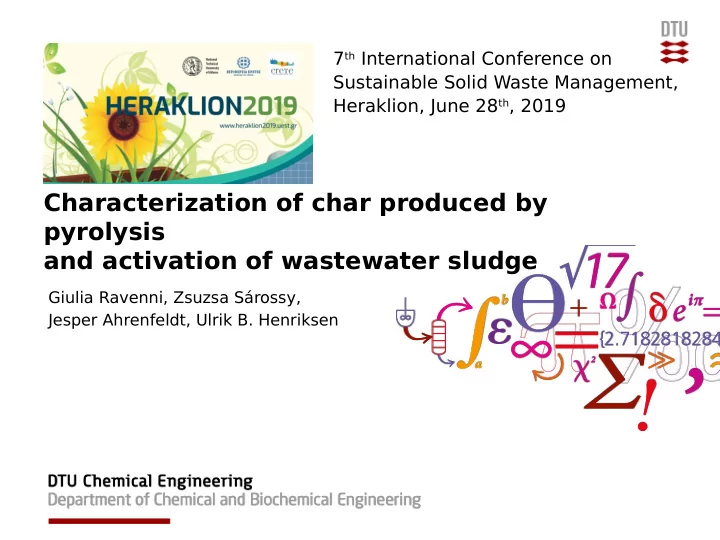

7 th International Conference on Sustainable Solid Waste Management, Heraklion, June 28 th , 2019 Characterization of char produced by pyrolysis and activation of wastewater sludge Giulia Ravenni, Zsuzsa Sárossy, Jesper Ahrenfeldt, Ulrik B. Henriksen
Adsorbents: a possible valorisation route? Traditional disposal routes • Spreading on agricultural land Alternative valorisation routes • Incineration are to be found! • Landfjll, discharge into water bodies Sludge-derived adsorbents for wastewater contaminants: • Dyes : Methylene blue, Reactive Red, Acid Yellow • Metals : Copper, Iron, Lead • Phenolics : Methylphenol, Bisphenol-A, Bromophenol • Phosphorus and Phosphates recent review papers on the topic (Hadi P . at al., 2015 and Devi P ., 2017) (Hadi P . et al. 2015) 2 DTU Chemical Engineering, Technical University of Denmark 28 June 2019
Drying and pyrolysis of wastewater sludge https://aquagreen.dk/ Drying stage Pyrolysis Carbonized sludge System currently operating at Odense wastewater treatment plan , VandcenterSyd (https://www.vandcenter.dk/viden/spildevand) 3 DTU Chemical Engineering, Technical University of Denmark 28 June 2019
Char composition 4 DTU Chemical Engineering, Technical University of Denmark 28 June 2019
Char thermogravimetric analysis N 2 atmosphere : loss of carbon fraction (≈ 16 wt%) visible after about 45 minutes. Afterwards the mass reduction progressed, leaving a residual mass of 80.5 wt%. Air atmosphere: oxidation at 900˚C left a residual mass 75.5 wt%, meaning that part of the inorganics left the sample in the gas phase. 5 DTU Chemical Engineering, Technical University of Denmark 28 June 2019
Steam activation of sludge char Steam activation (60 minutes) • ≈ 10 g of char activated in thermo-gravimetric reactor • ≈ 1 kg/h steam fmow • Activation temperatures: 650 – 700 – 750 – 800 – 900˚C 6 DTU Chemical Engineering, Technical University of Denmark 28 June 2019
Surface characterization – N 2 adsorption 77 K 7 DTU Chemical Engineering, Technical University of Denmark 28 June 2019
Surface characterization – N 2 adsorption 77 K 8 DTU Chemical Engineering, Technical University of Denmark 28 June 2019
ICP-OES analysis of inorganic fraction • Sludge-derived char had a relatively low content of heavy metals (Cr, Ni, Cu, Cd, Zn, Pb) • Cd and Cu concentrations resulted above the thresholds indicated in the Danish legislation relative to waste materials for agricultural purposes (Fødevareministeriet, 2018). • The concentration of Cd and other elements (S, Zn, Pb, Al) decreased with increasing activation temperature 9 DTU Chemical Engineering, Technical University of Denmark 28 June 2019
Conclusions • The analyzed sewage sludge char is rich in ashes and contains only about 16% of carbon • Physical activation with steam is only partially efgective in increasing the surface area and porosity of the char • Activation temperatures above 750˚C result in signifjcant degradation of the surface • With increasing activation temperature, some inorganic species (Zn, Pb, Al, Cd and S) are vaporized and leave the solid sample … and future work • Adsorption experiments using dyes and…? • Use of chemical activation (e.g KOH addition) for further improvement of surface area and porosity 10 DTU Chemical Engineering, Technical University of Denmark 28 June 2019
Acknowledgements The authors would like to acknowledge Danish Environmental T echnology Development and Demonstration Program (MUDP) for the fjnancial support of the project “ Circular resource utilization of residual sludge: Development of unit to produce Activated Carbon from Biochar .” Thank you! 11 DTU Chemical Engineering, Technical University of Denmark 28 June 2019
References • Hadi, P . et al. 2015. “A Critical Review on Preparation, Characterization and Utilization of Sludge-Derived Activated Carbons for Wastewater T reatment.” Chemical Engineering Journal 260: 895–906. • Devi, P ., Saroha A.K. 2017. “Utilization of Sludge Based Adsorbents for the Removal of Various Pollutants: A Review.” Science of the T otal Environment 578: 16–33. • Fødevareministeriet 2018, Bekendtgørelse om anvendelse af afgald til jordbrugsformål. https://www.retsinformation.dk/Forms/R0710.aspx? id=202047#id82759b62-4821-4e9a-93e9-935c1c076536 (accessed May 2, 2019). 12 DTU Chemical Engineering, Technical University of Denmark 28 June 2019
Vand Center Syd WWTP - Odense https:// www.vandcenter.dk/viden/spildevand 13 DTU Chemical Engineering, Technical University of Denmark 28 June 2019
ICP-OES analysis of inorganic fraction 14 DTU Chemical Engineering, Technical University of Denmark 28 June 2019
Recommend
More recommend